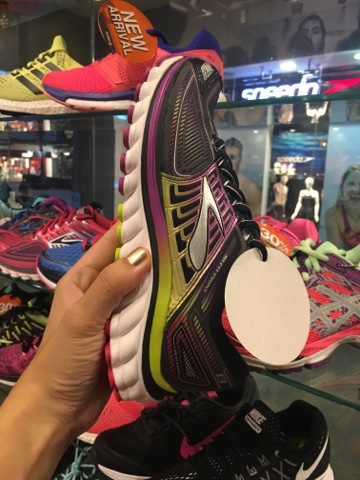Eat right, Run well
 |
| Of course I needed to try on the whole outfit, even if I only got the shoes. Hehe! |
So I read up on the right kind of food for runners, and I realized that I've been doing some things wrong. Thank you, Google!
Here are some guidelines that I've compiled based on the stuff I read and some I've experienced first hand.
1. Fuel Your Run
I realized that it was bad practice to go out for a run on empty. I even do that sometimes with our car, which has gotten me stuck in awkward situations. Yikes! Don't want that happening to me during a run. I thought that running on an empty stomach would make me lose weight. That may happen but that also means that I would lose energy and fatigue sooner. If the workout is something light and would take an hour or less, I don't think it would do any harm. But for longer distances, it's always a good idea to fuel up with the right food. The perfect pre-workout meal would be something that we're familiar with, low in fat and fiber (because we don't want to excite our intestines during the run), and high in carbs to give us a boost of energy. Here's a great read about The Best Food For Runners.
Here's another amazing guide for runners and a great source of recipes, 30 Best Foods for Runners :
2. Refuel During The Run
Refueling during the run is just as important as the pre-run meal, especially for long distances. According to Runner's World, "don't wait until you're hungry and tired to refuel. By that time, your tank will be empty, and it will be tough to recover. At first, try taking in fuel within 15 to 30 minutes of hitting the pavement. Take another fuel 15 to 30 minutes later--even if you don't feel hungry or tired. The idea is to keep your energy level steady and stop fatigue and hunger before it stops you. By the time you feel like you need the fuel, it may be too late."

One suggested to take Snickers bar instead, which more or less has the same ingredients as the energy bars available.
Whatever it is, the most important thing is to try them during a practice long run, before the actual run because you don't want to be racing to the nearest toilet instead of the finish line.
3. Don't Forget Your Recovery Meal
I would always hear this from my HIIT coach before...but I would always forget to prepare my "recovery meals". I learned that I should consume a protein-rich snack/meal to repair the muscles and help them become stronger, and carbohydrates to replenish the spent energy stores. These should be taken between 30 minutes to 2 hours after a workout. Here are some examples of Recovery Snacks For After A Run.
4. Hydrate Always
Hydration is essential, not only for running or working out. This is something I'm very guilty of: not drinking enough water. I think it's because I don't like using public toilets so I avoid drinking a lot of water to avoid peeing. I know...it's not good practice. I think even Joei has this problem, that's why she downloaded this app in her phone to monitor her water intake. It's called Waterlogged. It can be connected to a Fitbit and it will remind you to drink water.
There are a lot of benefits when we're well-hydrated. First, we avoid the risk of getting dehydrated. Since it's been so hot lately, we have to keep on drinking water to avoid heat stroke. Second, it helps move the wastes from our body. We don't need those "extras" when we run, right? Better to travel light. And lastly, our joints are properly lubricated...maybe that's why I experience knee pain from time to time? That can be my next research.
It's better to plan our meals ahead of time so that we can just focus on running during race day. I think with everything that we do, great strategic planning is key to success.
And since we have an 8 mile long run tomorrow morning, I've got to go... to get some good food and good rest. Maybe I'll see you there?

































